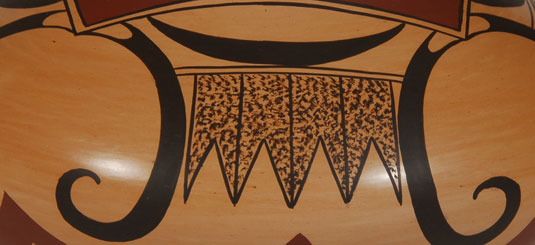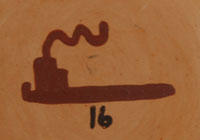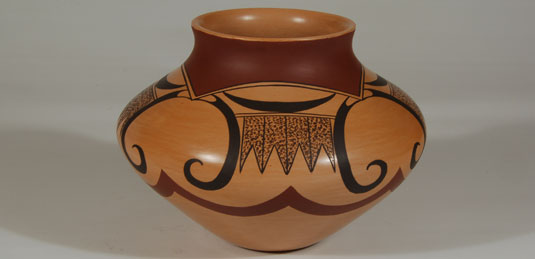Polacca Polychrome Inspiration for a Contemporary Jar [SOLD]
+ Add to my watchlist Forward to Friend
- Category: Modern
- Origin: Hopi Pueblo, Hopituh Shi-nu-mu
- Medium: clay, pigments
- Size: 4-5/8” height x 6-1/2” diameter
- Item # 25911 SOLD

Mark Tahbo often uses historic and prehistoric examples of Hopi pottery as his inspiration when creating designs on new vessels. He, by doing this, keeps the continuity of Hopi ceramics alive and brings the older designs back to the attention of today’s collectors.
This medium-size jar was inspired by a Hopi Polacca Polychrome jar (Sikyatki Revival), dating from 1890-1900, that was in the Thomas Keam collection and now resides at the Peabody Museum at Harvard University. At the time that Alexander M. Stephen cataloged the Keam collection, he categorized Polacca Polychrome as “modern” pottery because it was being made at the time he was working with Keam on documenting his collection. Modern pottery of that time (1890-1900) is now considered historic pottery.
The Polacca Polychrome that Tahbo used as his inspiration is a simplified version of what became Nampeyo’s “eagle tail” design. In Tahbo’s version, the design closely follows that of the Polacca Polychrome in its simplicity.
The vessel shape of this jar is somewhat like the Polacca Polychrome one with a rolled-out rim that is highlighted by a square around the neck filled with red paint. The red paint is from a stone that Mark grinds, so it is not a clay source as are most reds. The speckled pointed feathers are like the Polacca Polychrome ones and are simpler in style than the eagle tail feathers Nampeyo later employed. The variation Tahbo made to the original design is below the mid-point of the jar and is the deep red swags that encircle the jar—making the design a unique one based on a traditional one.
When Mark Tahbo delivered this jar to the gallery, he spent considerable time telling us exactly what he did, what his inspiration was, and why he chose to only change one design item. I have attempted to explain above what he told me and hope I have done it justice.
 Mark also has switched his signature element. Previously, he signed with his last name and a tobacco pipe. The pipe designates tobacco clan. He now feels like the pipe is the only item necessary for a signature and has now eliminated his name.
Mark also has switched his signature element. Previously, he signed with his last name and a tobacco pipe. The pipe designates tobacco clan. He now feels like the pipe is the only item necessary for a signature and has now eliminated his name.
Condition: new
Source: the artist
Recommended Reading: America’s Great Lost Expedition—The Thomas Keam Collection of Hopi Pottery from the Second Hemenway Expedition, 1890-1894, by Wade & McChesney

- Category: Modern
- Origin: Hopi Pueblo, Hopituh Shi-nu-mu
- Medium: clay, pigments
- Size: 4-5/8” height x 6-1/2” diameter
- Item # 25911 SOLD



